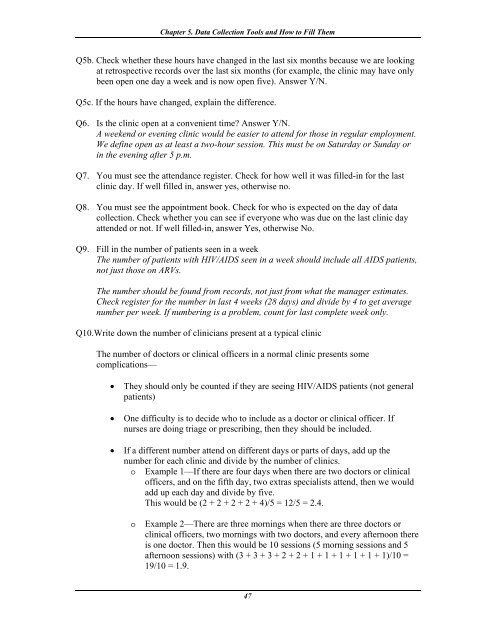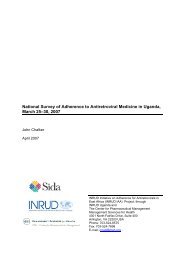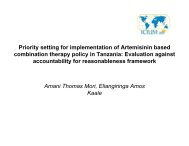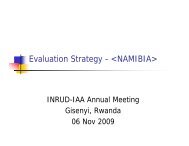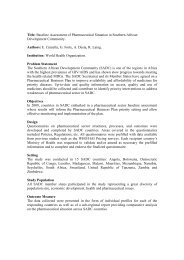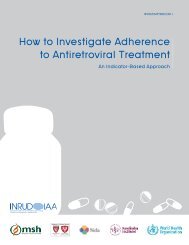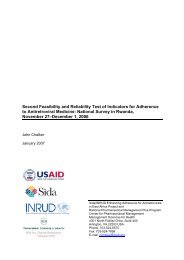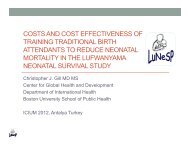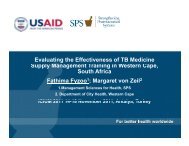How to investigate Adherence to Antiretroviral Treatment ... - INRUD
How to investigate Adherence to Antiretroviral Treatment ... - INRUD
How to investigate Adherence to Antiretroviral Treatment ... - INRUD
You also want an ePaper? Increase the reach of your titles
YUMPU automatically turns print PDFs into web optimized ePapers that Google loves.
Chapter 5. Data Collection Tools and <strong>How</strong> <strong>to</strong> Fill Them<br />
Q5b. Check whether these hours have changed in the last six months because we are looking<br />
at retrospective records over the last six months (for example, the clinic may have only<br />
been open one day a week and is now open five). Answer Y/N.<br />
Q5c. If the hours have changed, explain the difference.<br />
Q6. Is the clinic open at a convenient time? Answer Y/N.<br />
A weekend or evening clinic would be easier <strong>to</strong> attend for those in regular employment.<br />
We define open as at least a two-hour session. This must be on Saturday or Sunday or<br />
in the evening after 5 p.m.<br />
Q7. You must see the attendance register. Check for how well it was filled-in for the last<br />
clinic day. If well filled in, answer yes, otherwise no.<br />
Q8. You must see the appointment book. Check for who is expected on the day of data<br />
collection. Check whether you can see if everyone who was due on the last clinic day<br />
attended or not. If well filled-in, answer Yes, otherwise No.<br />
Q9. Fill in the number of patients seen in a week<br />
The number of patients with HIV/AIDS seen in a week should include all AIDS patients,<br />
not just those on ARVs.<br />
The number should be found from records, not just from what the manager estimates.<br />
Check register for the number in last 4 weeks (28 days) and divide by 4 <strong>to</strong> get average<br />
number per week. If numbering is a problem, count for last complete week only.<br />
Q10.Write down the number of clinicians present at a typical clinic<br />
The number of doc<strong>to</strong>rs or clinical officers in a normal clinic presents some<br />
complications—<br />
• They should only be counted if they are seeing HIV/AIDS patients (not general<br />
patients)<br />
• One difficulty is <strong>to</strong> decide who <strong>to</strong> include as a doc<strong>to</strong>r or clinical officer. If<br />
nurses are doing triage or prescribing, then they should be included.<br />
• If a different number attend on different days or parts of days, add up the<br />
number for each clinic and divide by the number of clinics.<br />
o Example 1—If there are four days when there are two doc<strong>to</strong>rs or clinical<br />
officers, and on the fifth day, two extras specialists attend, then we would<br />
add up each day and divide by five.<br />
This would be (2 + 2 + 2 + 2 + 4)/5 = 12/5 = 2.4.<br />
o<br />
Example 2—There are three mornings when there are three doc<strong>to</strong>rs or<br />
clinical officers, two mornings with two doc<strong>to</strong>rs, and every afternoon there<br />
is one doc<strong>to</strong>r. Then this would be 10 sessions (5 morning sessions and 5<br />
afternoon sessions) with (3 + 3 + 3 + 2 + 2 + 1 + 1 + 1 + 1 + 1 + 1)/10 =<br />
19/10 = 1.9.<br />
47


